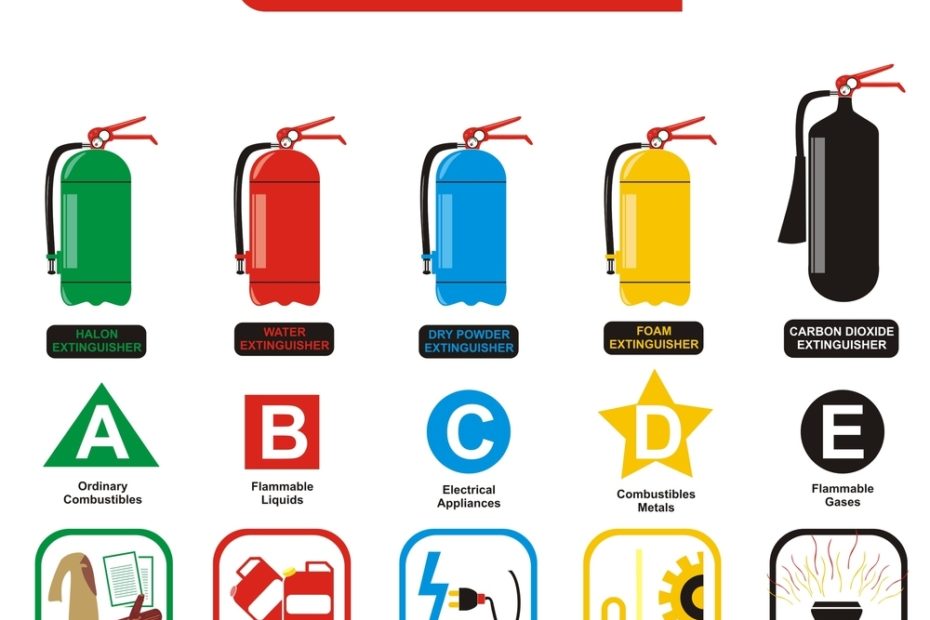Fire extinguishers are required by law for every business to have, so everyone should be able to find one.
On the other hand, a single fire extinguisher does not operate for all forms of fire. Numerous fire extinguishers may be found in the same way that there are different forms of fire.
Ensure you have the correct extinguisher for your building’s possible fire threats to secure your workplace’s basic safety.
Fire Chemistry Explained and Why Students need to Understand
To begin with, it’s helpful to understand the fundamentals of fire.
The following are brief descriptions of the five basic types of fire:
- Class A: Combustible solids such as wood or paper that are easily ignited.
- Class B: combustible liquids and gasses.
- Fires that include an energized electrical source as the ignitor are classified as Class C (once the source is removed, the fire is no longer classified as a Class C fire).
- Class D: Fire caused by metal (titanium, zirconium, magnesium, sodium)
- Animal or vegetable oils or fats may be used in cooking.
No matter what kind of fire it is, the following four ingredients will always be present:
- Fuel
- Heat
- Oxygen
- Chain Reaction
These four components are supposed to put out a fire, so portable fire extinguishers were invented.
Classifying fires based on these three factors makes it necessary to have specialized extinguishers for each type of fire. Class A fires can be safely doused with water, but class C fires can’t because water would carry the electrical current and pose a risk to operators.
Six different types of fire extinguishers are available.
Once you’ve learned about the many sorts of fires and why they require different types of fire extinguishers, we’ll go over the following six primary types of fire extinguishers and how they’re used:
FIRE EXTINGUISHER WITH ABC POWDER
Fire extinguisher ABC powder is a multi-purpose extinguisher, making it one of the most common to have on hand, and it has various advantages.
Monoammonium phosphate is the primary ingredient of a powder extinguisher. This has the effect of suffocating the flames by acting as a blanket.
People who use powder extinguishers to put out class A, B, and C fires can stop the chain reaction, which is something that water can’t do.
CARBON DIOXIDE FIRE EXTINGUISHER
CO2 fire extinguishers leave no residue and do not need to be cleaned up after use, making them one of the cleanest extinguishers.
Extinguishing CO2 is precisely what the name implies. As a result, the fire is effectively suffocated by a lack of oxygen. Class B fires that involve flammable liquids and electrical fires are the best use for this item.
FIRE EXTINGUISHER WET CHEMICAL
When a wet chemical extinguisher is used, it is mainly used to fight Class K fires, which use cooking fats or oils like animal or vegetable fats.
These fire extinguishers use a potassium-based solution that attacks flames from two directions.
That liquid mist that shoots out helps put out the flames by reducing the temperature. Second, thick soap-like material is formed due to the solution’s chemical interaction with the cooking medium, sealing the liquid’s surface and preventing re-ignition.
A wet chemical extinguisher is the best option when it comes to kitchen fires. On the other hand, class A fires may benefit from this technique, in which a substance like wood or paper has taken fire.
Fire Extinguisher with Water Mist
The most adaptable of the group, the water mist extinguisher, uses a more recent technology that is effective against a wide range of types of fire.
An extinguisher with this mechanism emits tiny water molecules that battle the blaze on many levels. In the first place, by dispersing so much water in a fog-like mist, oxygen levels in the air are cut down, which helps put out the fire.
Because water naturally moves heat away from a fire, the temperature drops.
Finally, the deionized water in these water mist extinguishers is likely the most notable feature (the minerals have been removed). Deionized water cannot carry electricity. Therefore, it may be used to extinguish flames that a regular water extinguisher couldn’t handle, such as burning liquids and gasses.
Using a water mist extinguisher, all classes of A, B, C, and K flames may be extinguished.
Foam Fire Extinguisher
It is possible to put out fires with foam extinguishers, but they will not put out fires with class A or B gas.
Foam is sprayed on the fire, which expands as soon as it meets the air. Fires are starved of fuel because of this covering, which prevents vapors from rising from the liquid and feeding them. In addition to providing a soothing sensation, the foam’s high-water content helps to keep it cold.
In addition to Class A fires involving wood, foam extinguishers are among the best for liquid flames like gasoline.
FIRE EXTINGUISHER CLEAN AGENT
Using a clean agent fire extinguisher is a gaseous method of extinguishing a fire. These are just a few of the advantages of this environmentally friendly product. It is non-conductive and safe for use when humans are present, leaves no residue, and has a minimal atmospheric lifespan.
Fires can be extinguished by lowering oxygen levels and preventing chain reaction. If you have a lot of electrical or computer equipment in your home or company, this is the appropriate flooring option. Most of these business’ time is spent putting out Class B and Class C fires.
